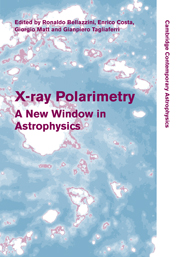Book contents
- Frontmatter
- Contents
- List of contributors
- Preface
- 1 X-ray polarimetry: historical remarks and other considerations
- Part I Polarimetry techniques
- Part II Polarized emission in X-ray sources
- Part III Future missions
- 37 Gravity and Extreme Magnetism SMEX (GEMS)
- 38 Programs of X-ray polarimetry in Italy
- 39 A polarimeter for IXO
- 40 Polarimetry with ASTRO-H soft gamma-ray detector
- 41 The Energetic X-ray Imaging Survey Telescope and its polarization sensitivity
- 42 PoGOLite: a balloon-borne soft gamma-ray polarimeter
- 43 Studies of neutron background rejection in the PoGOLite polarimeter
- 44 Observing polarized X-rays with PoGOLite
- 45 Pre-flight qualification tests of the PoGOLite detector system
- 46 The Gamma-RAy Polarimeter Experiment (GRAPE) balloon payload
- 47 POLAR: an instrument dedicated to GRB polarization measurement
- 48 Polarization detection capability of GRIPS
- 49 X-ray and γ-ray polarimetry small-satellite mission PolariS
- 50 GAP aboard the solar-powered sail mission
- 51 Hard X-ray polarimeter for small-satellite missions
- 52 Performance of hard X-ray polarimeter: PHENEX
- 53 GRB polarimetry with POET
- Author index
- Subject index
53 - GRB polarimetry with POET
from Part III - Future missions
Published online by Cambridge University Press: 06 July 2010
- Frontmatter
- Contents
- List of contributors
- Preface
- 1 X-ray polarimetry: historical remarks and other considerations
- Part I Polarimetry techniques
- Part II Polarized emission in X-ray sources
- Part III Future missions
- 37 Gravity and Extreme Magnetism SMEX (GEMS)
- 38 Programs of X-ray polarimetry in Italy
- 39 A polarimeter for IXO
- 40 Polarimetry with ASTRO-H soft gamma-ray detector
- 41 The Energetic X-ray Imaging Survey Telescope and its polarization sensitivity
- 42 PoGOLite: a balloon-borne soft gamma-ray polarimeter
- 43 Studies of neutron background rejection in the PoGOLite polarimeter
- 44 Observing polarized X-rays with PoGOLite
- 45 Pre-flight qualification tests of the PoGOLite detector system
- 46 The Gamma-RAy Polarimeter Experiment (GRAPE) balloon payload
- 47 POLAR: an instrument dedicated to GRB polarization measurement
- 48 Polarization detection capability of GRIPS
- 49 X-ray and γ-ray polarimetry small-satellite mission PolariS
- 50 GAP aboard the solar-powered sail mission
- 51 Hard X-ray polarimeter for small-satellite missions
- 52 Performance of hard X-ray polarimeter: PHENEX
- 53 GRB polarimetry with POET
- Author index
- Subject index
Summary
POET (Polarimeters for Energetic Transients) represents a concept for a NASA Small Explorer (SMEX) satellite mission, whose principal scientific goal is to understand the structure of GRB sources through sensitive X-ray and γ-ray polarization measurements. The payload consists of two wide field-of-view (FoV) instruments: a low-energy polarimeter (LEP) capable of polarization measurements in the energy range from 2–15 keV and a high-energy polarimeter (Gamma-Ray Polarimeter Experiment or GRAPE) that would measure polarization in the 60–500 keV energy range. The POET spacecraft provides a rotating zenith-pointed platform for dealing with any residual systematic effects in the polarization response and for maximizing the exposure to deep space. POET would be capable of measuring statistically significant polarization (for polarization levels in excess of 20%) for ∼80 GRBs in a two-year mission. High-energy polarization data would also be obtained for SGRs, solar flares, pulsars and other sources of astronomical interest.
Introduction
Gamma-ray bursts (GRBs) are amongst the most energetic events in the universe, and have stimulated intense observational and theoretical research. Theoretical models indicate that a refined understanding of the inner structure of GRBs, including the geometry and physical processes close to the central engine, requires the exploitation of high-energy X-ray and γ-ray polarimetry. To date, observations have been of limited sensitivity and subject to poorly understood systematics. POlarimeters for Energetic Transients (POET) is a SMEX mission concept that is capable of measuring the high-energy polarization of GRBs and other sources of astronomical interest.
- Type
- Chapter
- Information
- X-ray PolarimetryA New Window in Astrophysics, pp. 355 - 358Publisher: Cambridge University PressPrint publication year: 2010



